Of all the places we were due to visit on our trip to the Balkans, I was most excited at the prospect of finally visiting Sarajevo. Famous for the events that triggered the start of the First World War, for Torvill and Dean (especially in my home city of Nottingham) and for the horrific siege that the city suffered in the 1990s, this is a city that consistently punches above its weight in its ability to attract headlines. I came into Sarajevo with high expectations and I’m happy to say that our visit exceeded these; it’s now right up there as my favourite European city.
East meets West
This label has traditionally belonged to Istanbul, but after a few days I became convinced that Sarajevo should perhaps be the rightful holder of this strapline (for what it’s worth). It may be less than a tenth of the size of its Turkish rival, but the blend of mosques and churches, of merchants’ alleys and shopping malls, and of the sound of ubiquitious Balkan techno-pop drowning out the call to prayer created an atmosphere that I haven’t encountered elsewhere.
Most of the city’s mosques and churches (and even the synagogue, home to a good little museum) are freely open to the public. It is a compact city centre and perfect for strolling in and out of the alleys and markets. The narrow lanes were reminiscent more of Turkey than of the grey and soulless Yugoslavia that I had last visited over 20 years ago.
Ghosts of Sarajevo past
There are many signs of Sarajevo’s recent bloody conflict and I mentioned these in a recent post. Those who remember the news coverage from the early 1990s may recognise the yellow block that is the Holiday Inn, the only working hotel during the siege and where the world’s press did their best to report on the unfolding tragedy. From the many viewpoints on the city’s surrounding hills it is easy to see where new buildings have sprung daringly from the rubble and where others are yet to be touched. When you stand on the hillsides it’s impossible not to consider that those vantage points were the strategic positions of the troops who tried to strangle the city.
Sarajevo had a rich history long before the latest conflict and you don’t have to look far to uncover signs of this past. The Yugoslav years are remembered in a kitsch bar that is shamelessly themed around the life of Tito, with garish displays of his life and old propaganda posters on the walls of the cafe. Positioned rather ironically behind the National History Museum, this hang-out is popular with the city’s students and has pictures of the former leader mingling with the world’s good, bad and ugly.
Further back again and the perhaps Sarajevo’s most important gunshot (there’s so many to choose from) was fired in 1914 by Gavrilo Princip opposite the city’s Latin Bridge. His effort killed the Archduke Franz Ferninand and set into motion a chain of events that quickly and inevitably led to the start of the Great War. Princip was originally honoured as a hero, and only in recent years was his memorial (a set of bronze footprints) moved from the spot where the assassination occurred and into the more appropriate setting of the nearby museum.
Looking back beyond the events of 1914, Sarajevo is still home to some of the best examples of Ottoman architecture, and a few even survived the recent war. In fact the influence of the city’s many rulers over the generations has left its legacy in a rich mix of architctural styles.
Diverse cuisine
Sarajevo’s split personality is perhaps most evident in its food. While the Balkan staple food (pizza) is available on every street, there is plenty of Turkish influence in some of the Bosnian fare on offer. Meat kebabs (cevapcici) and burek (stuffed pastry) are served in abundance while the pekara (bakery) signs point to a world of irresistable cakes and sweet pastries. And no trip to Sarajevo is complete without trying a Bosnian coffee. Strong enough to put hairs on your chest, or perhaps to strip them off, the Bosnian coffee set is an intricate collection of pots and makes a popular gift, if the market traders are to be believed.
Our favourite find (courtesy of Lonely Planet) was Mala Kuhinja. Translating as ‘little kitchen’ this tiny restaurant just behind the cathedral has no menus and just a few cosy tables. On entering the waiter greeted us, checked if we had any allergies or aversions and proceeded to tell us about the dishes we would get. The chef then got to work in the open kitchen and prepared us a feast. The quality of the meal was first class and the whole lunch experience made this our best meal of the whole trip (the price was very reasonable too). They just need a little work on their website…
Don’t miss…
1. The old men playing chess in the park by the Orthodox cathedral. This is a Sarajevo institution and I have to admit to never having imagined that people could get so involved in a chess game. When one player had opened up a clear run for his pawn to get to the other end of the board, we could have easily imagined we were at the finishing line in a horse race, such was the excitement in the voices of those around us.
2. Climbing one of the nearby hills to get a view of the city. From the old city quarter there is a clear view of a hill fort just beyond the city. The fort can be reached in a gentle half hour of walking and offers superb views of the city.While climbing the hill the road passes through several sleepy surburban streets, where only the odd bullet hole or ruined building give any clue that the neighbourhood has ever been woken from its lazy slumber.
It is also the sunset hang-out spot for young Sarajevans so expect plenty of noise and techno-music rather than a spiritual sunset experience.
3. A trip out to the Tunnel Museum. This is a simple yet very powerful display at the spot where the people of the city built a tunnel under the airport runway to bring supplies into the city during the three year siege. You can still walk through a part of the tunnel, and the curator of the museum is one of the family who owned the land where the tunnel was built and who were deeply involved in its construction and in keeping it secret. A trip to the museum involves a tram and bus ride from the city.





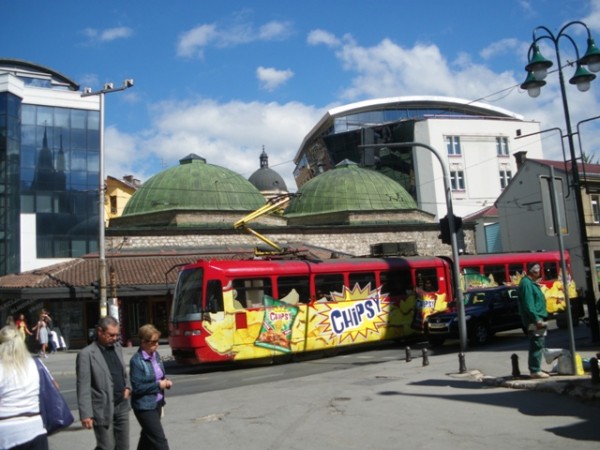
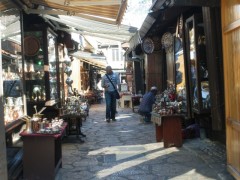
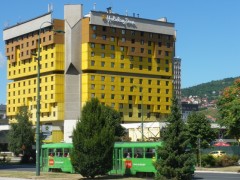
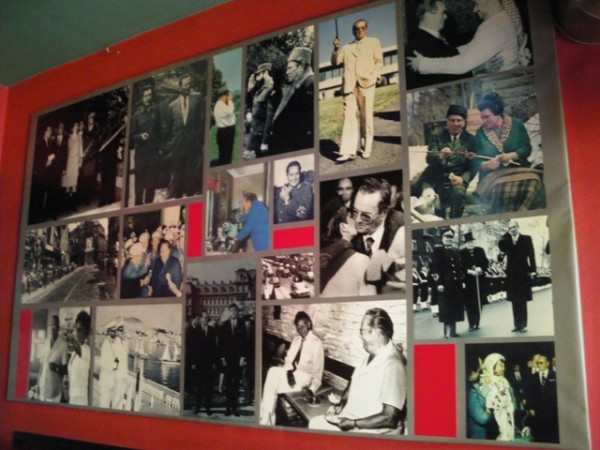
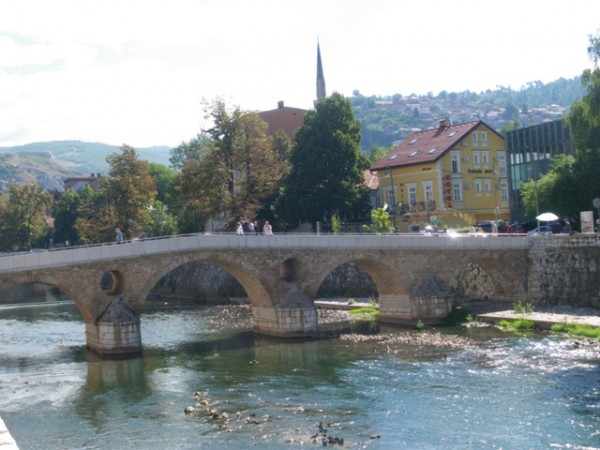
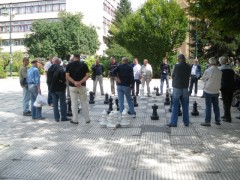
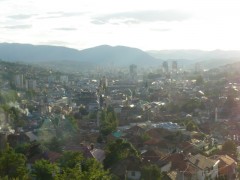
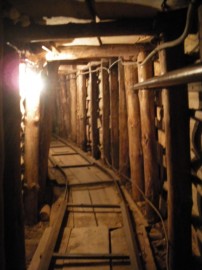
I’m so JEALOUS!
Balkan pizza! Cevapcici! Burek! oh.. and i would like Bosnian coffee please even if it means growing chest hair;)
This Mala Kuhninja place sounds divine – perfect for foodies. perfect for me.
Wow. What an incredible post and a lovely journey to Sarajevo! I am getting right on to my Serbian friend to take her up on her offer of a road trip to through the Balkans next summer. Novi Sad, Zagreb, Sarajevo. I want to see them all.
Thanks! I think Bosnian coffee is very much for the men folk – probably for the reasons I’ve mentioned 😉
Thanks Emm. Now we never ventured into Serbia or most of Croatia; that’s for another trip. The road trip sounds like a trip you need to do 🙂
Don’t tell anyone (she says, posting on a public blog) but I’m secretly learning Serbian so that I can surprise my friend later in the year and start planning our road trip.
Loved the post as soon as you said you were from Nottingham. But how is Sarajevo famous for Torvil and Dean?
Hi Natalie, thanks for stopping by. Torvill and Dean won Olympic Gold in Sarajevo in 1984 and got the maximum scores for the first ever time. It was THE defining moment of those winter Olympics (well, for Nottingham anyway). http://www.youtube.com/watch?v=t2zbbN4OL98
Wow, Andy. You were quick with your answer. I was curious because I grew up in Nottingham. Torvil and dean happened when I was a toddler though. I don’t think anyone has matched them in terms of performance since.
The memories came flooding back as I read your post. I visited sarajevo in 2000 and the first bit of advice I received was not to take short cuts unless I wanted to find a mine!
I spent five eye opening weeks during which I met some amazing people and was able to venture into the Old Town in addition to what was the main drag. I remember a cafe that I used to go to for lunch which offered a selection of hearty stews which they served in metal bowls. There was also a trout farm in Pale (30 minutes from Sarajevo), where they served fries (only) with your trout. I was told afterwards that the journey to pale criss-crossed the old faction lines making it impossible for some of my colleagues to go. So much for my rose coloured glasses view that the war was over!!!
I had planned to go there on my last weekend however there was a landslide making a section of road impassable and the alternative route would have taken about two hours.
I am tempted now to pay another visit.
Thanks for the memories. Yes, I understand there are still many mined areas – a sad legacy. I hope you make it back someday.
Super post. Sarajevo wasn’t on my list, but it is now!
Andy, thanks for this information on Sarajevo. I haven’t read a lot about this city but am fascinated with Eastern Europe, the history, and its culture. I haven’t been here but I really do love this area. This was an excellent read on the city and it made me want to visit even more. Even though I knew Archduke Ferdinand’s assassination I have to admit I didn’t realize it happened in Sarajevo. I love this overview and the history and wish this area of Europe got a lot more attention than it does (or maybe it’s kinda nice it’s not so popular).